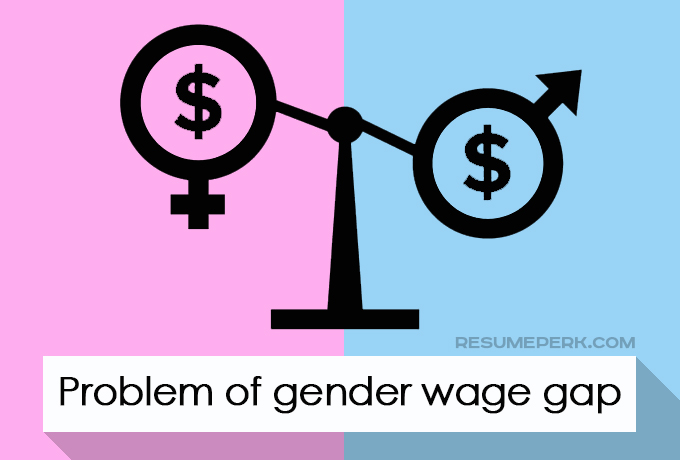Problems Of Gender Wage Gap: 10 Facts
Although the equality between men and women is promoted in all spheres of life, such problem as gender wage gap still exists. Many have heard that women typically earn less than men on the similar role, however, not everyone understands the scope of the problem. According to Aauw.org, women make only 80 cents for every dollar men make. In other words, to make the amount a man made in 2016, a typical woman will have to work until the 12th of April, which is known as Equal Pay Day.

Such difference in earnings is influenced by multiple factors including discrimination at the workplace, education, ethnicity, and even state. If you are planning to write a resume that will help you earn more, keep in mind that such difference will exist anyway.
Let’s have a closer look at the main facts about the wage gap:
- The gender pay difference starts in childhood
As was revealed by The Guardian, there’s a difference even between the amounts of pocket money parents give to boys and girls. Boys are paid around 15% more than girls for fulfilling the same tasks. - …and continues to grow over time
Unfortunately, the gender pay gap tends to grow with age. The pay difference, as stated by Americanprogress.org, equals around $4K for women aged 15-24 who are working full time. However, a woman who is 45 or above makes in average $15K less than a man of her age does. - College degrees don’t change the situation
Women gain the majority of college degrees these days. Nevertheless, a pay gap exists even for female college graduates. As a result, women find it harder to pay off their student loans than their male counterparts do. Even the similarity of education and work experience doesn’t lead to equal pay to men and women. - Pay gap exists in all industries
Gender wage gap covers all industries of the United States. According to U.S. Bureau of Labor Statistics, men earn more than women in all fields except for five jobs. Surprisingly, the difference in salary exists even in those professions which are traditionally considered as female jobs. - The pay gap affects women of color and ethnic minorities even more
As mentioned above, the difference is earnings affects women of any age, level of education and industry. However, Latinas and African American women suffer from even bigger wage gap. As stated by Americanprogress.org, women of ethnic minorities who are working full time earn 55 to 60 cents for every dollar earned by white, non-Hispanic men. Gender pay gap exists within ethnic groups as well (for instance, black women make 82 cents for every dollar made by black men). - The salaries of working mothers decrease
As a result of discrimination, women tend to earn less as their similarly qualified male colleagues. The situation also changes for working mothers. It’s well-known that motherhood often negatively reflects on women careers. It affects the salary, too: according to The Guardian, the salaries of working mothers decrease by 4% with every child. For working fathers, however, the situation is quite different. The earnings of a man grow by 6% when he becomes a father. - Pay gap is different for every state
Surprisingly, the wage gap also varies from state to state. For example, the smallest pay gap is in New York and Delaware, where women make 89 cents for every dollar made by men (Aauw.org). The largest gaps are in Wyoming and Louisiana (64 and 68 cents respectively). With an average US statistics of 80 cents that women make for every dollar made by men, in some states the gap is impressive. - The wage gap is a complex problem
A wage gap is partly explained by the fact that there are more women than men among the low-paid and part-time workers. Such positions do not assume the career promotion. Even as part-time workers, women are paid less than men on the similar job. Moreover, women are more likely to take the unpaid leave (for example, maternity leave) to provide care to their family. - About 40% of pay gap can’t be explained by measureable factors
The salary is often affected by many factors including years of professional experience, membership in affiliations, education, etc. However, not always the difference in pay can be explained by those factors. The research had shown that after eliminating professional and racial differences around 40% of pay difference remained unexplained. Thus, this is another argument that discrimination in pay based on gender still exists. - Discrimination exists even in online job advertising
The above source has also shared the fact that advertising of highest-paying job opportunities are much often shown to men than to women. Modern technology also contributes to a gender wage gap.
Conclusion
The difference in pay between men and women unfortunately exists. In addition to women being discriminated during the interview, they need to work more to earn as much as men do. Not only this is a discriminatory practice, but also the economic security of families is at stake. We need to take actions in order to protect women rights and totally eliminate the gender wage gap.
Feeling that you are underpaid in your current job? Maybe, it’s time to find a new employment with more progressive company. Update your resume with us at an affordable fee to make your next career move more effective.
Recommended reading:
- Where to Buy Resume That Will Work?
- Try Yourself in Blogging by Submitting Your First Guest Post
- 8 Reasons to Find Part Time Jobs
- 8 Things You Should Never Wear to Work
- 11 Signs Of Reliable Resume Writing Companies
- Top Taboo Topics You Should Never Discuss With Colleagues


